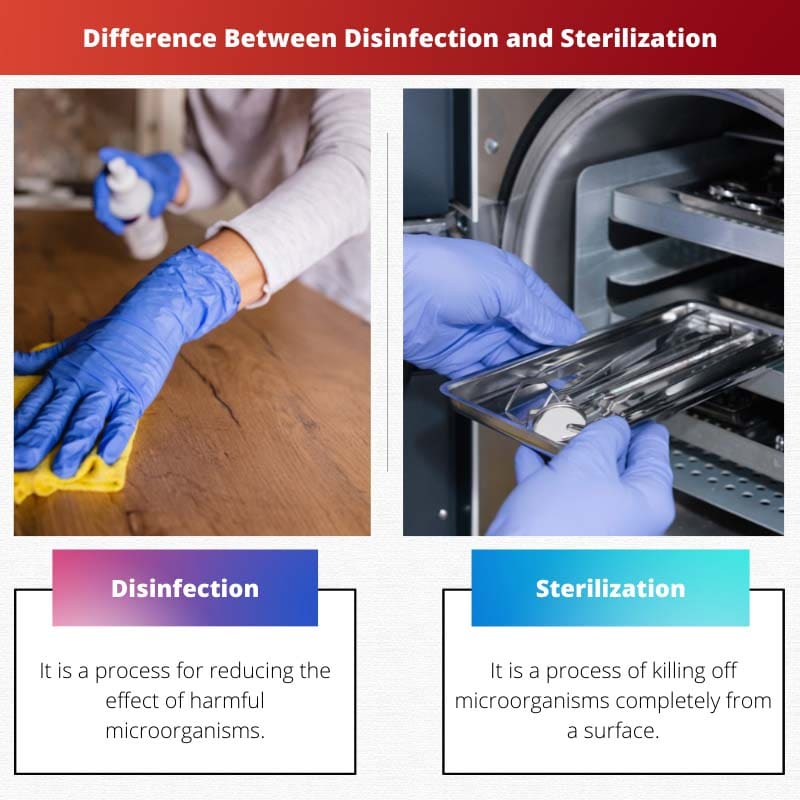Several microorganisms live on surfaces that are not cleaned. They cause numerous diseases and affect the health of people adversely.
They are even responsible for the rotting of food. Therefore, it is better to kill them or just stop them from growing. Two common ways to do so are disinfection and sterilization.
Key Takeaways
- Disinfection destroys most harmful microorganisms, while sterilization eliminates all microbial life forms.
- Sterilization methods include heat, chemicals, and radiation, whereas disinfection primarily uses chemical agents.
- Disinfection is used for surfaces and non-critical medical instruments, while sterilization is required for critical medical devices and surgical instruments.
Disinfection vs Sterilization
Disinfection is reducing the number of microorganisms on a surface to a safe level for public health. Sterilization eliminates or destroys all forms of microbial life on a surface or object through physical or chemical means. It is used in healthcare settings, laboratories, and in the production of medical devices and drugs.

Disinfection is a way to minimize the effects of microorganisms on a surface. Through this process, only vegetative cells are killed, and there is no effect at all on spores.
Due to this, it is not used at all to clean wounds. Some disinfecting agents that are commonly used for this purpose include alcohol, phenol, iodine, and chlorine.
Meanwhile, sterilization is the process of killing off all microorganisms on a surface. Through the process, both vegetative cells and spores are killed.
Due to this, it is used very for cleaning wounds. Some ways of carrying out the process of sterilization include heat, radiation, steam, filtration, etc.
Comparison Table
| Parameters of Comparison | Disinfection | Sterilization |
|---|---|---|
| Meaning | It is a process for reducing the effect of harmful microorganisms. | It is a process of killing off microorganisms completely from a surface. |
| Effects | It only kills vegetative cells and not any spores. | It kills vegetative cells as well as spores. |
| Use | It is used in day-to-day life very often. | It is primarily used in medical procedures and for research. |
| Wounds | It is not used to clean wounds. | It is used to clean wounds. |
| Agents | Disinfecting agents include alcohol, phenol, iodine, and chlorine. | Sterilization agents include heat, radiation, filtration, and even steam. |
| Examples | Examples of disinfection include pasteurization, sanitisers, disinfecting urinals, etc. | Examples of sterilization include cleaning medical tools before surgeries. |
What is Disinfection?
Disinfection is the process of using a chemical substance or any compound in order to reduce the effects that harmful organisms have on surfaces.
During the process, vegetative cells are killed off completely. However, there is no effect at all on spores.
For this purpose, it is not used for medical purposes like cleaning wounds but is effective in day-to-day life.
Some of the most common disinfecting agents include alcohol, phenol, iodine, and chlorine. These are used for several purposes, such as pasteurization, sanitisers, and even disinfecting urinals.
However, various viruses, fungi, and bacteria are not affected by disinfectants. Due to this, it is always better to take more serious steps.
An important aspect of the process is that disinfection can only be carried out with other factors in play.
These include contact time, disinfectant type, temperature, disinfectant concentration, and even turbidity.
If all these are present to the right degree, only then will disinfection take place in the correct way.
Disinfection is also a widespread method for cleaning water resources. Many groundwater sources contain germs and other microorganisms.
Numerous techniques, such as ozonation, light treatment, chlorination, chlorination, etc., are used to reduce their effects.

What is Sterilization?
Sterilization is another cleaning process in which various chemical and even physical methods are used to kill microorganisms.
This process not only reduces their effects but makes the surface entirely clean. Both vegetative cells and spores are destroyed during sterilization.
Due to this, it is used extensively in medical procedures such as cleaning wounds. However, it is not used very in day-to-day life.
Some of the most common agents for sterilization include chemicals, heat, irradiation, filtration, and even high pressure.
Most of these methods are used for cleaning surgical tools before a medical operation.
Other applications include racialization, food irradiation, and even protecting contamination of solar system bodies from earth material.
Unlike disinfection, sterilization, in theory, kills off all types of fungi, viruses, and bacteria. However, it is not always true that sterilization kills off all germs and microorganisms.
This also brings forward an aspect that sterilized objects must be maintained after the process. Or else germs and microorganisms are likely to infect them again.
Regardless, sterilization is not always practical or cost-effective when it comes to large water bodies.
It includes large amounts of chemicals being mixed into the water, which to some degree, is very difficult. Moreover, there are chances of environmental hazards erupting.
Main Differences Between Disinfection and Sterilization
- Disinfection is a process for reducing the effect of harmful microorganisms, whereas sterilization is a process of killing off microorganisms completely from a surface.
- Disinfection only kills vegetative cells and not any spores, whereas sterilization kills vegetative cells as well as spores.
- Disinfection is used in day-to-day life, whereas sterilization is primarily used in medical procedures and research.
- Disinfection is not used to clean wounds, whereas sterilization is used to clean wounds.
- Disinfection agents include alcohol, phenol, iodine, and chlorine, whereas sterilization agents include heat, radiation, filtration, and even steam.
- Examples of disinfection include pasteurization, sanitisers, disinfecting urinals, etc., whereas examples of sterilization include cleaning medical tools before surgeries.




